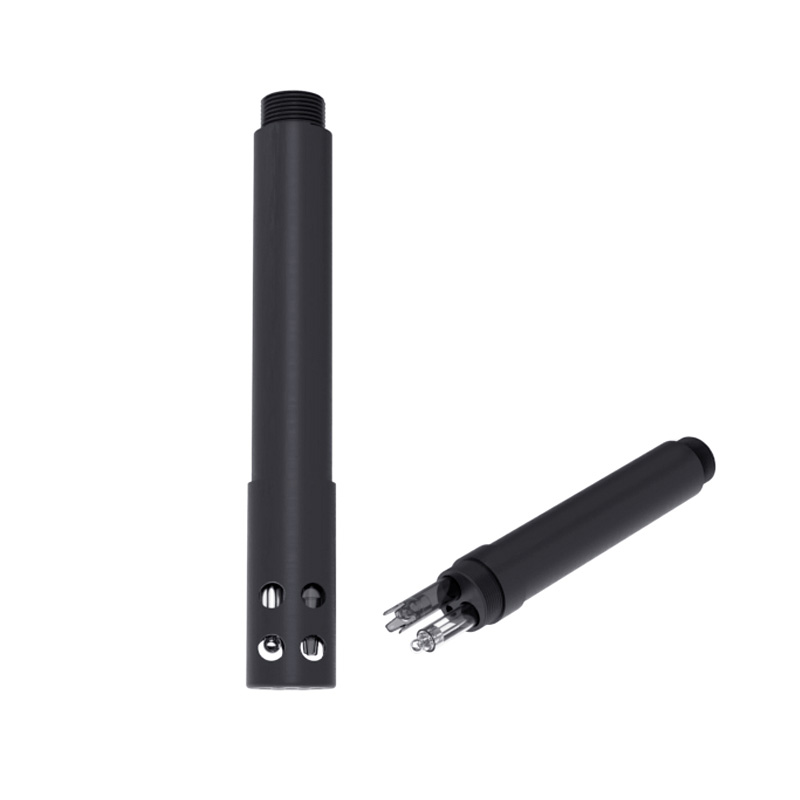
Residual Chlorine Sensor
Model:FT-S4
Brand:fengtu
1. Residual Chlorine Sensor application environment description
Residual Chlorine Sensor is suitable for monitoring of residual chlorine in groundwater systems and pipe networks in drinking water, as well as in process control.Residual Chlorine Sensor is used in drinking water treatment plants, canning plants, drinking water distribution networks, swimming pools, cooling circulating water, water quality treatment projects and other occasions where continuous monitoring of residual chlorine content in aqueous solutions is required.
2.Residual Chlorine Sensor technical parameters
| pH sensor | ||
| Range and resolution | 0~14(PH) | 0.01 |
| Accuracy | ±0.1PH; ±0.3℃ | |
| Residual chlorine sensor | ||
| Range and resolution | 0~5.00 mg/L | 0.01 |
| Accuracy | ±5% of reading; ±0.3℃ | |
| Communication method | RS485(MODBUS-RTU) | |
| Shell material | ABS | |
| temperature compensation | Automatic temperature compensation | |
| pH compensation | Automatic pH compensation | |
| Cable length | Standard 5 meters | |
| Supply voltage | 12-24VDC(0.3W@12V) | |
| Waterproof level | IP68 | |
| Installation method | Flow cell installation, 3/4NPT | |
3.Residual Chlorine Sensor electrical connection
1.Installation
Use the matching flow cell to install.The sensor and the flow cell are installed closely.Ensure that the sensor measurement part is placed near the water inlet of the flow cell.Try not to face the water outlet to ensure a stable flow rate.It is recommended that the flow rate be controlled at 30-60L/h to ensure testing.accuracy.
2.Electrical connection
The cable is a 4-core twisted pair shielded wire, and the line sequence is defined as follows:
Red wire—power cord (12~24VDC)l
Black wire—ground wire (GND)
Blue line—485A
Green Line—485B
Note: The color of the cable may vary slightly due to different production batches, please refer to the silk screen printing of the cable.
The wiring sequence should be carefully checked before powering on to avoid unnecessary losses caused by wiring errors.
4.Maintenance and maintenance
1.PH electrode
When used for the first time or not used again for a long time, the sensitive bulb and reference junction should be immersed in 3.3mol/L KCI solution for more than 2 hours.Before use, it should be washed and dried with deionized water (or distilled water) to prevent impurities from being brought into the liquid being measured.
The wiring terminal part should be kept clean and dry.The sensor should be cleaned when not in use and inserted into a protective sleeve with 3.3mol/L KCI solution, or the sensor should be inserted into a container with 3.3mol/L KCI solution.
Check whether the wiring terminals are dry.If there are stains, please wipe them with absolute alcohol and dry them before continuing to use them.The sensor should avoid being immersed in deionized water, protein solution, strong acid and alkali solution, and acidic fluoride solution for a long time, and prevent contact with silicone grease.If the sensor has been used for a long time, its glass film may become translucent or have sediments attached.In this case, it can be washed with dilute hydrochloric acid and rinsed with water.
When the sensor has been used for a long time and measurement errors occur, it can be calibrated and corrected by cooperating with the instrument.If the sensor cannot be calibrated and measured after maintenance and maintenance in the above way, it means that the sensor has failed.Please replace the sensor.
2.Residual chlorine electrode
New electrodes and electrodes that have been placed for a long time need to be activated before use.Place the sensor in tap water for 24 hours.If the returned value is inaccurate, you need to do the following:
Zero point and slope calibration of sensors
Return to factory for inspection
Article address:https://www.sqqx.net/en/Water-quality-sensor/Residual-Chlorine-Sensor.html

 +86 15898932201
+86 15898932201 Get a Free Quote
Get a Free Quote



